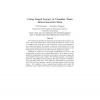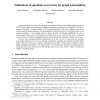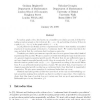76 search results - page 10 / 16 » Some Small Cancellation Properties of Random Groups |
ICAIL
2009
ACM
14 years 4 days ago
2009
ACM
We propose an analysis of the codified Law of France as a structured system. Fifty two legal codes are selected on the basis of explicit legal criteria and considered as vertices ...
GD
1998
Springer
13 years 11 months ago
1998
Springer
We consider the problem of visualizing interconnections in railway systems. Given time tables from systems with thousands of trains, we are to visualize basic properties of the co...
STOC
2006
ACM
14 years 1 months ago
2006
ACM
It has been known for some time that graph isomorphism reduces to the hidden subgroup problem (HSP). What is more, most exponential speedups in quantum computation are obtained by...
CMOT
2002
13 years 7 months ago
2002
We introduce a diffusion of innovation model based on a network threshold approach. Realistic network and threshold data were gathered regarding the diffusion of new software tool...
RSA
2010
13 years 5 months ago
2010
A random graph order, also known as a transitive percolation process, is defined by taking a random graph on the vertex set {0, . . . , n − 1}, and putting i below j if there i...



